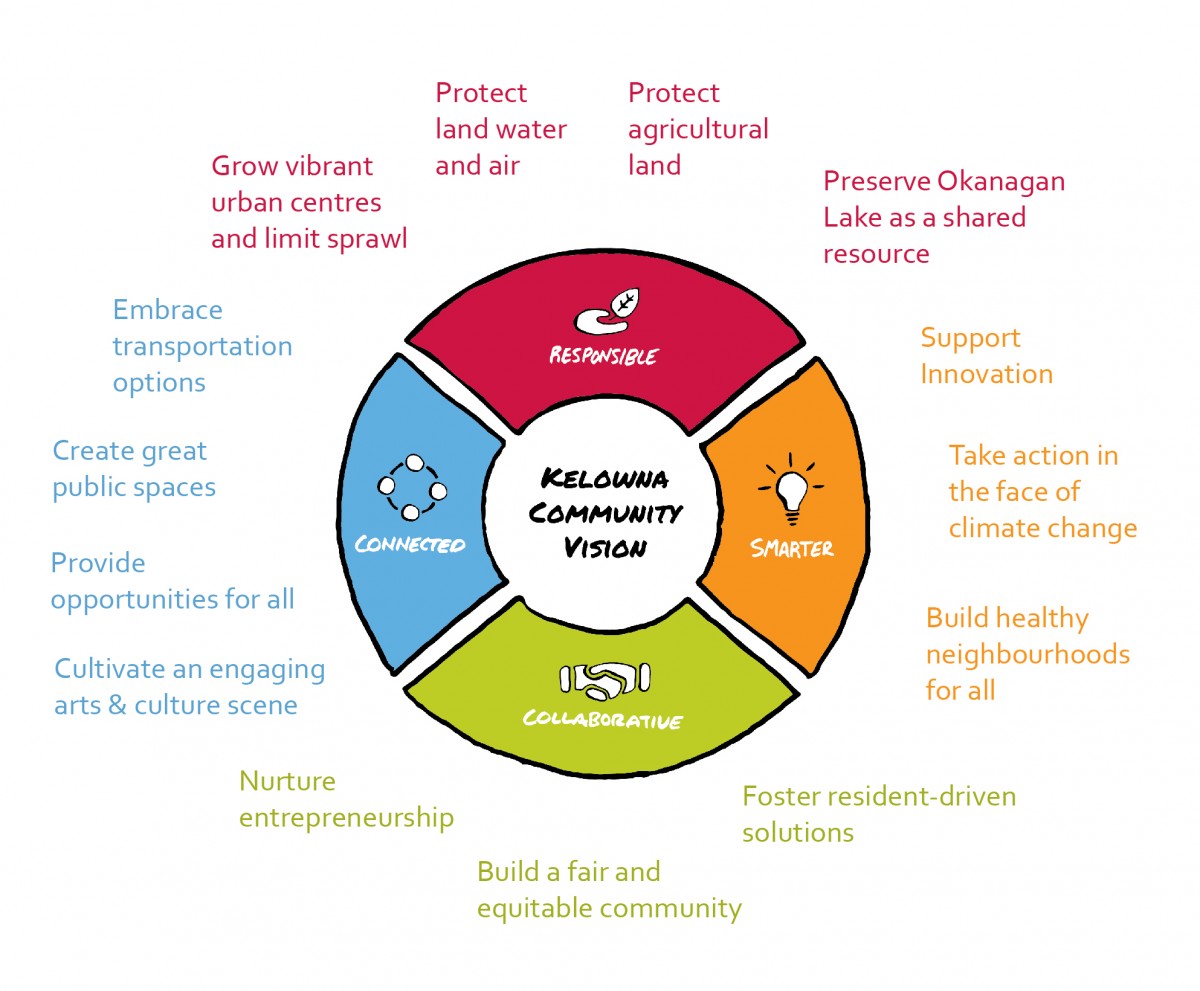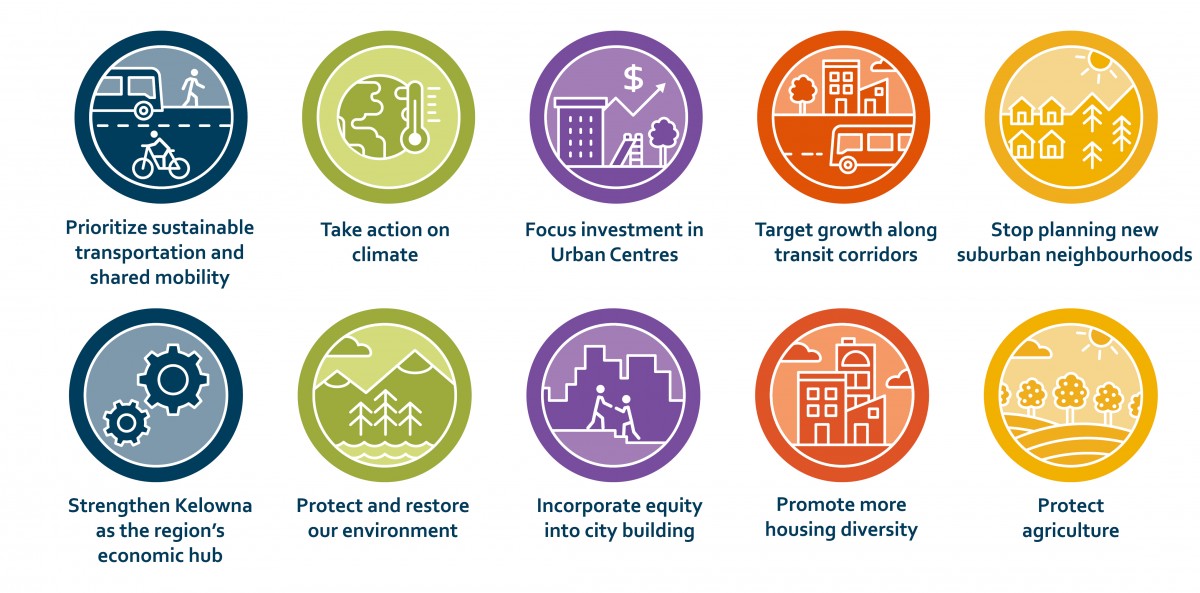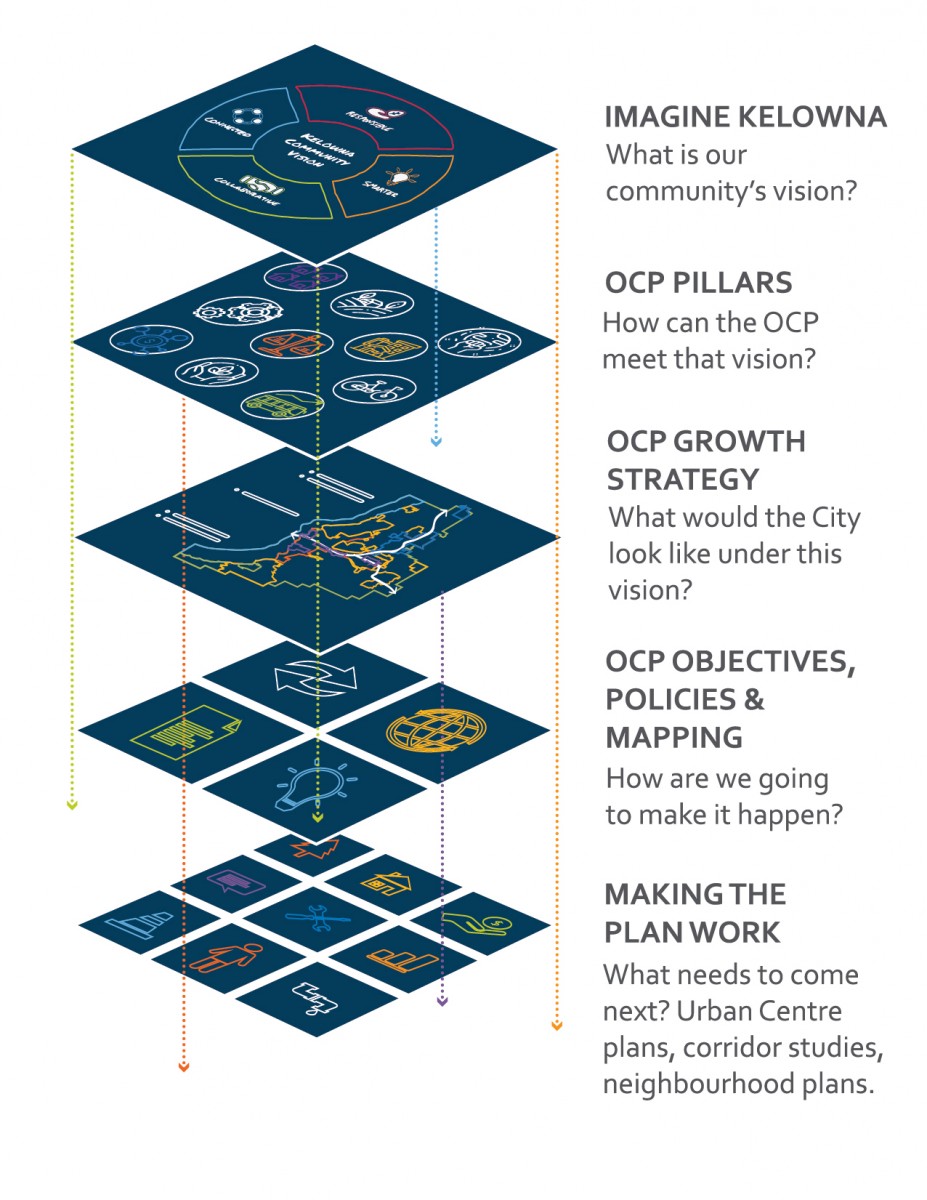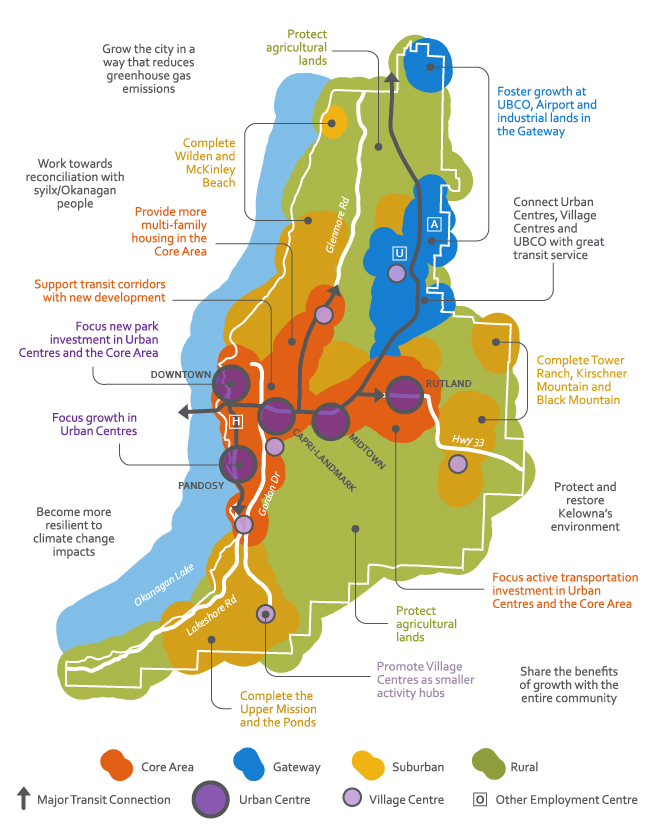2040 Official Community Plan
The Big Picture

What is Kelowna? To some people, it’s an outdoor oasis filled with trails to hike and bike and lakes as a stunning backdrop. To others, this city is an economic powerhouse home to robust traditional sectors like agriculture and construction, and burgeoning new sectors such as information technology. Kelowna is all these things and much more. Most importantly, Kelowna is a collection of people. People who have been here for generations, people who have just recently started to call this place home and even people who are just visiting. Kelowna finds its strength and resilience in the many ways in which its diverse residents and visitors interact, maintain, and ultimately shape the City’s built and natural environment.
The 2040 Official Community Plan (OCP) reflects Kelowna’s people driven growth. It works from and encourages diverse public participation. It directs growth by employing knowledge of the past and innovation of the now to imagine and create a better future.
As one of the fastest growing cities in Canada, Kelowna is rapidly evolving. Its economy is diversifying, many of its neighbourhoods are transforming, and people are choosing new ways to get around. In short, Kelowna is becoming a more urban and dynamic city and the pace of change is unlikely to let up. By 2040, Kelowna is expected to be home to another 45,000 people. This transition can be exciting, bringing a new energy, amenities, employment and educational opportunities. Yet, rapid change can also bring anxiety as some residents grapple with increased traffic, home price escalation and the transformation of the small town they remember.
This growth is also taking place in a time of great societal, technological and environmental change, challenging the way that Kelowna has grown in the past. Advances in technology are changing how we work, shop and communicate. The impacts of a changing climate are now being felt, and income inequality is requiring new approaches to keeping the City an affordable place to live.
In this era of rapid growth and change, it is clear that there are new opportunities to consider along with challenging and complex choices to be made. We must choose where and how we grow. We must choose how we invest and where we invest. We must make these choices while recognizing and building on what we already love about this city. The choices are rarely easy or obvious and often involve making difficult trade-offs.
How we make these choices must be guided by a bold vision and a clear strategy - a sometimes difficult undertaking. Fortunately, the citizens of Kelowna have crafted this bold vision called Imagine Kelowna which outlines what kind of city they want to live in. The 2040 Official Community Plan is one of the most critical strategies that will help us realize that vision by guiding how and where Kelowna will grow in the future. It includes strategic direction on how the City will house 45,000 more residents and how they will get around. It illustrates where new parks and schools will be located and where employment areas will be focused. It guides how we will face the challenges of climate change while making the City more equitable.
Each pillar, objective, policy and guideline in this Plan represents a deliberate choice made about how Kelowna will evolve in the future. With this guidance, Kelowna will not only grow in a way that withstands the coming changes but will flourish.
Imagine Kelowna is the community’s response to the forces of change. Kelowna is a city in transition and Imagine Kelowna captures the community’s vision, principles and goals to thrive in the face of unprecedented growth and change. It is the result of almost 4,000 resident contributions. It is a vision created by our community for our community.
Kelowna Community Vision
Kelowna is a thriving mid-sized city that welcomes people from all backgrounds. We want to build a successful community that honours our rich heritage and also respects the natural wonders that contribute to our identity. As a place with deep agricultural roots, Kelowna understands the need to protect our environment, manage growth and be resilient as our future unfolds.
Kelowna is a thriving city and an incredible place to call home. To flourish in the future, we need to be bold, resilient and unafraid to do things differently. The community has made it clear that as we grow we need to look out for one another and protect the stunning environment that sustains us. Our vision for an inclusive, welcoming, prosperous and sustainable future calls upon us all to be ambitious and to embrace the challenges ahead. As a result, the principles and goals that make up Imagine Kelowna work together as a system to help the community achieve its vision (see Figure 1.1).
In the face of rapid change, the 2040 Official Community Plan helps realize the Imagine Kelowna vision by leveraging growth to make our community more resilient and inclusive and to enhance the quality of life for Kelowna citizens. Through land use decisions, capital investments and community partnerships, this 2040 Official Community Plan will be the framework to guide growth and development over the next twenty years so the Kelowna we live in reflects the Imagine Kelowna vision.
 |
| Figure 1.1: Imagine Kelowna community vision. |
Using the Imagine Kelowna goals, this OCP identifies a series of pillars, objectives and policies that will guide decision-making for the City’s growth to 2040.
The 2040 OCP sets strategic direction for the way Kelowna grows, supporting housing choices, green open spaces, employment hubs and preserving our natural features and landscape to maintain Kelowna’s distinctiveness. To promote quality of life, 10 OCP Pillars have been established as a foundation on which to build the more detailed policy direction of the 2040 Official Community Plan. These pillars are informed by the bold vision of Imagine Kelowna, Council input, and engagement with Kelowna citizens, partners and stakeholders.
 |
| Figure 1.2: Official Community Plan Pillars |
Growing Kelowna’s Urban Centres – Downtown, Capri-Landmark, Pandosy, Rutland and Midtown – into vibrant hubs of activity is one of the major goals of Imagine Kelowna. It’s also a critical component of accommodating growth without more urban sprawl. To support this, the Official Community Plan directs public and private investments towards providing more jobs, housing, transportation options, parks and other amenities in and around the Urban Centres.
Imagine Kelowna focuses on limiting urban sprawl and growing in a way that is more environmentally and financially sustainable. In recognition of this goal, the Official Community Plan signals that suburban neighbourhoods already approved will continue to grow into more complete communities but no new suburban neighbourhoods would be considered.
Investing in more transit service makes it a more attractive option, but for it to be truly effective, there needs to be more people living, working and shopping nearby. With this in mind, the Official Community Plan focuses growth in the five Urban Centres and along major transit corridors that connect them with a goal of putting more people and more jobs within easy walking distance of reliable, direct transit service.
One of Imagine Kelowna’s goals is to build healthier neighbourhoods that support a variety of households, incomes and life stages. Having the housing that Kelowna citizens need is critical to achieving this goal. With this in mind, the Official Community Plan signals a wider variety of housing types and not just single family homes or small apartments. This housing is focused in areas where residents have easier access to jobs, amenities, transit and active transportation routes. In addition, this Official Community Plan supports more rental housing options.
Equity is the fair distribution of opportunities, power, and resources to meet the needs of all citizens. It’s a common theme in Imagine Kelowna, with goals that include providing opportunities for people of all ages, abilities and identities, and building a community where everyone has the same opportunity to succeed and thrive and no one is excluded. To address these goals, equity and inclusion policies are woven throughout the Official Community Plan to ensure that as Kelowna grows the benefits are shared across the community. It also identifies ways that reconciliation with syilx/Okanagan people and culture can be strengthened as the city grows.
Nurturing a culture of entrepreneurship, supporting innovation and fostering inclusive prosperity are important parts of Imagine Kelowna. To achieve this vision, the Official Community Plan supports employment growth in the Urban Centres, industrial lands and other areas in the City. Growth and expansion of major post-secondary institutions, like Okanagan College and UBCO, as well as the Kelowna International Airport will continue so that Kelowna can foster more home-grown talent and be more connected to the world.
Agriculture has played a crucial role in Kelowna’s economy for generations and is a big part of Kelowna’s identity. Local food production is also becoming even more important in the face of a changing climate. As such, protecting agricultural lands is key goal of Imagine Kelowna. The Official Community Plan supports this critical component of our economy, identity and food security by limiting urban growth into agricultural lands and supporting their viability.
Embracing different types of transportation options is a key goal of Imagine Kelowna. To make this goal a reality, the Official Community Plan targets improvements to public transit, active transportation and sidewalk networks - especially in the Urban Centres, the Core Area and UBCO. To align with the other goals of Imagine Kelowna, this more diverse transportation network must prioritize safety, accessibility, and equity so that it truly works for all citizens.
Over the past century, Kelowna’s growth has come at the cost of the natural environment and many priceless natural ecosystems have been lost or severely compromised. However, Imagine Kelowna envisions a city where the protection of land, water and air resources is strengthened and the health of Okanagan Lake is preserved. The Official Community Plan supports this vision by protecting ecosystems and restoring others to a healthier state.
Through Imagine Kelowna, residents have spoken clearly that action needs to be taken to not only reduce the community’s greenhouse gas emissions but also to become a more resilient community in the face of a changing climate. To take action, the Official Community Plan focuses growth in a way that is more compact, energy-efficient and better prepared to adapt to events like floods, wildfires, drought and other climate change impacts.
The Growth Strategy illustrates the major land use directions that the 2040 Official Community Plan will be taking to create the city envisioned in the Pillars and in Imagine Kelowna. It consists of five Growth Strategy Districts in the city. Each district has its own role in realizing the vision outlined in the Growth Strategy and in supporting the pillars and the Imagine Kelowna vision (see Figure 1.3 and Map 1.1).
Like the Pillars, the Growth Strategy is part of the foundation for the OCP’s land use plan, objectives, policies, guidelines and implementation plan. Amendments to the OCP must consider the extent to which the proposal deviates from the Growth Strategy.
Kelowna’s five Urban Centres – Downtown, Pandosy, Capri Landmark, Midtown and Rutland – will act as the hubs for activity in in the city, providing the highest concentration of employment, shopping, entertainment and housing. To accomplish this, the top priority in Urban Centres is employment, such as offices, retail and restaurants, and post secondary institutions, followed by housing so that citizens have more opportunities to live closer to where they work or go to school. New parks and other amenities should also be prioritized, along with investments in sidewalks, pathways, cycling routes and transit to improve quality of life in Urban Centres.
Policy direction for Urban Centres can be found in Chapter 4.
The Core Area is made up of the city’s more central residential neighbourhoods as well as some large commercial and industrial areas along Highway 97. Housing variety is the top priority in the Core Area, especially in forms like four-plexes, townhouses and low rise apartments. Employment should also be encouraged in Village Centres, Regional Commercial lands along Highway 97 and in industrial lands. To ensure that Core Area neighbourhoods offer a high quality of life, continued efforts on parks, amenities and transportation options are central to their success.
Policy direction for the Core Area can be found in Chapter 5.
The Gateway includes the University of British Columbia Okanagan (UBCO) campus, Kelowna International Airport (YLW) and surrounding industrial and commercial lands. While the Urban Centres will continue to be the largest employment hubs in the city, growth in these emerging employment centres is important to the economy of the region. This growth will be facilitated by protection of industrial land and improvements to the transportation network, most notably transit to the airport and UBCO.
Suburban Neighbourhoods are those residential communities outside of the Core Area, but within the Permanent Growth Boundary. Efforts in Suburban Neighbourhoods should prioritize building complete communities through the development of Village Centres that offer local services. Continued residential growth should also respect the natural context these neighbourhoods find themselves in.
Policy direction for Suburban Neighbourhoods can be found in Chapter 7.
Rural Lands are located outside of the Permanent Growth Boundary and are mostly composed of agricultural lands and natural areas. Small pockets of residential neighbourhoods are also included in these areas; however, they are not signaled for growth. Protection of these agricultural and natural lands is the top priority in this district.
Policy direction for Rural Lands can be found in Chapter 8.
The 2040 Official Community Plan is a strategy to guide decision-making and navigate change as Kelowna continues to grow. It identifies changes needed to other City plans, bylaws and regulations. It prioritizes investments in assets and infrastructure, while being responsive and adaptable through monitoring and regular updates.
The OCP is intended for use by all members of the Kelowna community. Kelowna citizens and community organizations can use the OCP to see how and where the city will grow and change, ensuring they stay both informed and involved in decision-making processes. The 2040 OCP can be used by businesses and public institutions to help make major investment decisions, guiding choices to anchor their continued momentum as the economic engines of the city. The development community can have a clear and predictable picture of where and how the City will grow strategically while remaining flexible enough to support innovation in new development.
The OCP is also a high level policy guidance document and will require the balancing of various objectives, policies and directions to help make decisions. At times, decisions may have to prioritize some directions over others, depending on the specific context or a project or application, and it may not be possible to meet every policy in the OCP. In other cases, some policies may appear to conflict with one another. This will require flexibility for interpretation by Staff and Council to reconcile how a specific proposal or project best meets the vision outlined in the Pillars and the Growth Strategy.
The 2040 OCP’s framework starts with the higher level direction provided by Imagine Kelowna and the OCP Pillars, and moving to more detailed actions in policies and implementation actions.
 |
| Figure 1.4: Official Community Plan Policy Framework |
Imagine Kelowna outlines the community’s vision for how city will respond to growth and change in the future and identifies a series of principles and goals for our city. This vision served as the framework for the development of the 2040 OCP.
The OCP Pillars are the essential and transformative elements of the 2040 OCP and represent how the Plan intends to put the Imagine Kelowna vision into action. They guided the creation of the Plan’s objectives and policies.
The OCP Pillars are intended to help make decisions on amendments to the OCP by ensuring that amendments continue to reinforce the critical and key directions. They are also central to the monitoring and evaluation of the Plan’s success and form the basis for the Plan’s monitoring and evaluation approach outlined in Chapter 16: Making the Plan Work.
The Growth Strategy is a high level illustration of how and where the city will grow when guided by the OCP Pillars. Much like the OCP Pillars, it is intended to provide high level direction and to guide objective and policy development.
 |
| Figure 1.3: Official Community Plan Growth Strategy. |
Each Growth Strategy District (Map 1.1) plays a key role in the city’s evolution and includes its own set of directions and priorities, such as housing, employment or agricultural protection that are outlined earlier in this chapter and is discussed in greater depth in each district chapter (Chapters 4-8). These priorities are intended to help users navigate nuanced and challenging decisions, while providing a clear understanding of what the critical components for success are to realize the vision of each Growth Strategy District.
The 2040 OCP’s objectives are statements of outcomes to meet the intent of the Growth Strategy and the OCP Pillars. In contrast, policies are specific courses of action that contribute to meeting a specific objective. These objectives and policies are organized into a series of chapters, some of which are framed by one of the five Growth Strategy Districts, while others apply to the City as a whole. The District-based objectives and policies tell the story of how the vision for that district will be achieved, while the other chapters apply to all areas of the City. Each chapter highlights which Pillars are best met through its objectives and policies.
When seeking policy direction, both the District based chapter and the city-wide chapters should be referenced.
These are the activities that need to take place following the OCP’s adoption to put the plan into action. They include more detailed planning studies, neighbourhood plans and monitoring of outcomes to see how effectively the plan is moving towards the directions of the OCP Pillars and ultimately, Imagine Kelowna.
Cities are complex, and the 2040 OCP aligns the interdependencies of systems such as land use, transportation, environment, the economy and equity to be integrated. As such, the systems of city-building are highly interdependent, and require careful consideration to ensure all components are working in harmony. The City of Kelowna is at a pivotal time in its evolution, as we welcome 45,000 more residents and we embark on a more urban future.
The Official Community Plan vision will require us to work together as a community to build our future city and alongside organizations, institutions, businesses, agencies and other levels of government to change the way we work together, how we make decisions and how we engage with Kelowna residents. The choices ahead will not be easy ones, as the challenges of growing and urbanizing invite many competing interests. We need to be strong and courageous and acknowledge the trade-offs that are ahead, but the vision for our future is ours to realize. Today is not just about choices for ourselves, but for those of future generations. To allow them to experience such quality of life, our proactive planning will shape our future city and how it will respond with infrastructure, how businesses will thrive, how parks will give recreational opportunity, and how innovation will flourish. This is our future city, and it comes to life through the OCP’s actions and decisions that we collectively will make.




